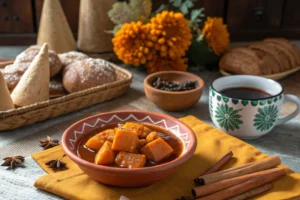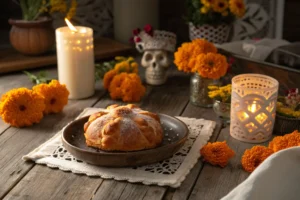Croissants are the ultimate test of baking mastery—flaky, layered, buttery clouds of dough that are traditionally made with loads of dairy. But what if you’re craving the classic croissant experience without the butter and milk? Enter the Claire Saffitz spelt croissant recipe, adapted for a completely dairy-free lifestyle. Using spelt flour instead of traditional wheat and high-quality non-dairy butter, this recipe delivers all the crispy edges and tender centers of a French bakery classic—minus the dairy.
Table of Contents
In this detailed guide, we’ll explore why Claire Saffitz’s approach to croissant-making is so special, how to successfully work with spelt flour, and how to substitute dairy products without sacrificing taste or texture. We’ll walk you through every step of the process, troubleshoot common pitfalls, and even suggest some creative variations and serving ideas. If you’re serious about learning the secrets of spelt croissants the dairy-free way, you’re in the right place.
- Check out Claire’s traditional croissant breakdown before diving into our spelt-based version: Claire Saffitz Croissants Recipe
Claire Saffitz Spelt Croissant (Dairy-Free)
A tender, flaky twist on the classic French croissant—made with spelt flour and dairy-free ingredients. Inspired by Claire Saffitz’s techniques, this recipe delivers golden layers, rich flavor, and a satisfying bake with zero dairy.
- Prep Time: 60 min
- Cook Time: 20 min
- Total Time: 1 hour 20 minutes
- Yield: 12 croissants 1x
- Category: Baked Goods
- Method: Laminated Dough
- Cuisine: French
- Diet: Vegan
Ingredients
4 cups white spelt flour (plus extra for dusting)
2¼ tsp instant yeast
3 tbsp organic cane sugar
1½ tsp sea salt
¾ cup unsweetened almond, oat, or soy milk (lukewarm)
1 cup block-style dairy-free butter (cold, such as Miyoko’s or Naturli)
1 tsp lemon juice or apple cider vinegar (optional)
For brushing: 1 tbsp oat milk + 1 tsp maple syrup
Optional fillings: dairy-free chocolate chips, almond paste, or dairy-free cream
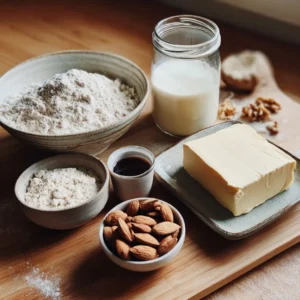
Instructions
Activate Yeast: Combine warm dairy-free milk with 1 tbsp sugar. Stir in yeast and let sit 5–10 min until foamy.
Make Dough: Mix flour, remaining sugar, salt, and activated yeast. Add vinegar if using. Knead gently until smooth. Chill 4+ hours.
Prep Butter Block: Form vegan butter into a 6×6-inch square between parchment. Chill until firm.
Laminate: Roll dough, encase butter, then do 3 letter folds, chilling 30 minutes between each. Final chill: 1 hour minimum.
Shape: Roll dough, cut into triangles, and roll into croissants. Place on lined trays.
Proof: Let rise 2–3 hours at 75°F until puffy and jiggly.
Brush & Bake: Preheat to 400°F. Mix oat milk and maple syrup. Brush on croissants. Bake 18–22 min. Cool and serve.
Notes
Work in a cool room to prevent butter leakage.
For savory variations, try vegan pesto or sautéed mushrooms.
Croissants freeze beautifully before or after baking.
Use block-style butter only—tub spreads don’t laminate well.
Nutrition
- Serving Size: 1 croissant
- Calories: 220
- Sugar: 4g
- Sodium: 180 mg
- Fat: 12g
- Saturated Fat: 4.5g
- Unsaturated Fat: 6.5g
- Trans Fat: 0g
- Carbohydrates: 25g
- Fiber: 3g
- Protein: 4g
- Cholesterol: 0mg
Why Claire Saffitz’s Croissant Recipes Stand Out
Who Is Claire Saffitz?
Claire Saffitz is a celebrated pastry chef and YouTube sensation known for breaking down complicated bakes into approachable steps. A former Bon Appétit editor and host of “Gourmet Makes,” Claire has earned a reputation for her deep technical understanding and love of traditional techniques—especially when it comes to laminated doughs like croissants.
Her philosophy emphasizes patience, quality ingredients, and the science behind the bake. That’s why so many people turn to her croissant tutorials—she makes a complex process feel achievable. But while her standard recipe uses classic French butter, this dairy-free variation adapts her techniques to suit alternative diets without sacrificing quality.
What Makes Her Croissant Techniques So Popular?
Saffitz doesn’t just tell you what to do—she explains why each step matters. From the initial mixing to final baking, her croissant method is loaded with techniques to improve structure and flavor. Here’s what sets her recipe apart:
- Layering with intent: Claire emphasizes precise lamination, which is key to those signature flaky layers.
- Temperature control: Her step-by-step chilling and proofing guides help prevent butter leaks—even with non-dairy butter.
- Ingredient quality: Saffitz urges the use of the best flour and fats available. In our version, that means sourcing premium dairy-free butter with high fat content for better lamination.
If you’re adapting a croissant to be both spelt-based and dairy-free, starting from a high-level recipe like Claire’s gives you a serious head start. Her recipe structure is solid, and with a few swaps and tweaks, it becomes perfect for dairy-free baking.
What Is Spelt Flour and Why Use It in Croissants?
Spelt vs. All-Purpose Flour: Key Differences
Spelt is an ancient grain that’s been cultivated for thousands of years—long before modern wheat became the go-to for baking. Although it still contains gluten, spelt flour behaves quite differently in recipes like croissants, especially when used as a 100% replacement.
Here are some key differences between spelt and all-purpose flour:
| Characteristic | Spelt Flour | All-Purpose Flour |
|---|---|---|
| Gluten Strength | Weaker gluten, more delicate | Stronger gluten, elastic |
| Flavor Profile | Nutty, mildly sweet | Neutral |
| Absorption | Lower liquid absorption | Higher absorption |
| Processing | Less refined, often stone-ground | Highly processed |
The weaker gluten in spelt makes the dough more fragile to handle—but it also results in a softer crumb and a more tender bite, which works beautifully in dairy-free laminated doughs. You’ll need to adjust hydration slightly (less water), and avoid overworking the dough to prevent tearing.
Health Benefits and Digestibility of Spelt
Spelt isn’t just an interesting baking alternative—it’s also packed with nutritional benefits:
- Higher in protein than most wheat flours
- Richer in fiber, which helps digestion
- Contains vitamins B2, manganese, and niacin
- Considered easier to digest than modern wheat by many people with sensitivities
Because it’s a whole grain with a different structure than modern wheat, spelt may be tolerated better by individuals who don’t have celiac disease but still want to reduce their wheat intake.
Using spelt in croissants may sound unconventional, but it’s a great way to add depth of flavor, a tender texture, and a slightly rustic look to your pastry—all without dairy. Plus, its mild nuttiness pairs beautifully with fillings like dairy-free cream or dairy-free chocolate.
Ingredients You’ll Need for a Spelt Croissant Recipe
Choosing the Right Spelt Flour (White vs. Whole)
Not all spelt flours are created equal. For croissants, the flour type you use will greatly influence the dough’s texture, hydration, and flakiness.
White spelt flour (also called light spelt) is milled without the bran and germ. It’s the closest in texture to all-purpose flour and produces a smoother, more elastic dough—ideal for croissant lamination.
Whole spelt flour includes all parts of the grain. It has a richer flavor and higher fiber content but makes the dough heavier and harder to laminate without tearing. You can use it, but blending it 50/50 with white spelt flour works better for structure.
Here’s a quick comparison:
| Spelt Type | Texture | Best Use in Croissants |
|---|---|---|
| White Spelt | Fine and smooth | Great for layers and softness |
| Whole Spelt | Dense and coarse | Adds nutty flavor, use in moderation |
For this recipe, we recommend using white spelt flour for the dough and reserving whole spelt (if desired) for light dusting or a 25% blend.
Dairy-Free Alternatives to Traditional Ingredients
Classic croissants are made with milk, butter, and sometimes cream—all of which need to be swapped out to make this version dairy-free. Fortunately, there are plenty of high-quality plant-based substitutes that still give you the texture and flavor you want.
Here’s what you’ll need:
- White spelt flour – 4 cups (plus more for dusting)
- Instant yeast – 2 ¼ tsp
- Organic cane sugar – 3 tbsp
- Non-dairy milk (unsweetened almond, soy, or oat) – ¾ cup
- Sea salt – 1 ½ tsp
- Non-dairy butter block – 1 cup (such as Miyoko’s or Naturli)
- Lemon juice or apple cider vinegar – 1 tsp (optional, for extra dough elasticity)
- Dairy-free cream – optional filling (see our dairy-free cream recipe)
- Dairy-free chocolate chips – optional filling (check our guide to dairy-free chocolate chip cookies)
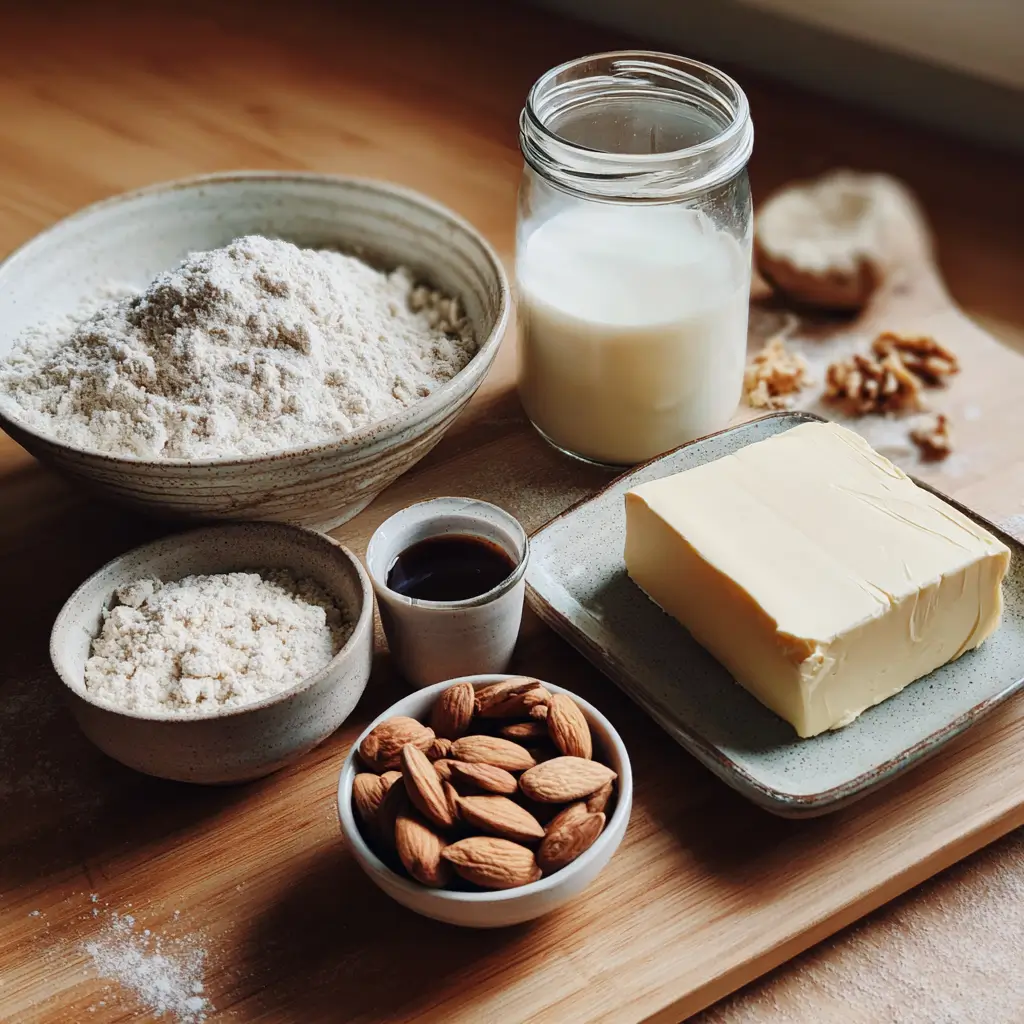
Pro Tip: Use a block-style vegan butter instead of tub margarine. It should be cold, firm, and high in fat (80%+). This ensures clean, distinct layers when laminated.
You can also lightly brush the croissants before baking with a mix of unsweetened oat milk + maple syrup to give them that golden color in place of an egg wash.
Step-by-Step – How to Make Claire Saffitz’s Spelt Croissants
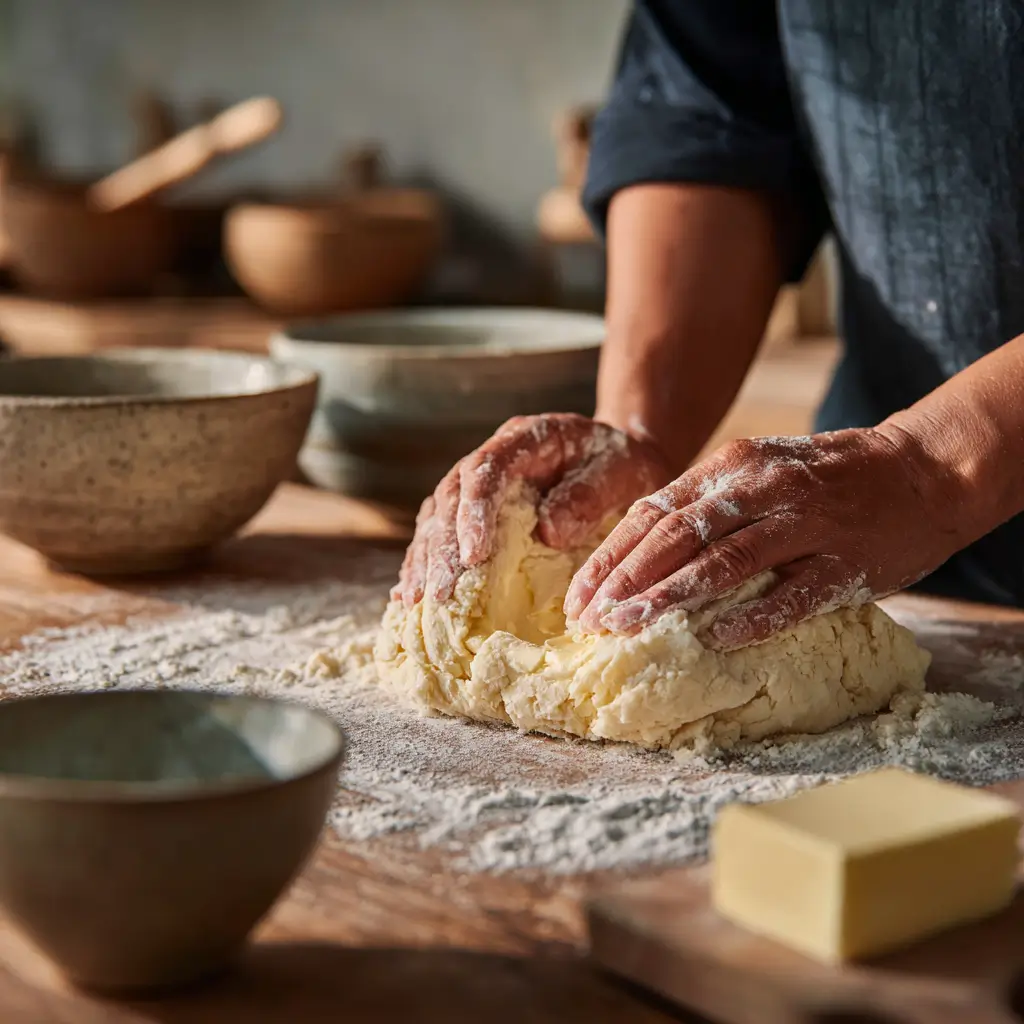
Preparing the Dough: Tips for Success
Before we get into lamination, you need a solid base dough. Spelt is more delicate than regular flour, so gentle handling is key.
Step 1 – Activate the Yeast
In a large bowl, mix ¾ cup of warm (not hot) dairy-free milk with 1 tbsp sugar. Sprinkle in 2 ¼ tsp instant yeast. Stir gently and let it sit for 5–10 minutes until foamy. This tells you the yeast is alive and ready to rise.
Step 2 – Mix the Dough
In a separate bowl, combine 4 cups of white spelt flour, the remaining sugar, and 1 ½ tsp salt. Slowly pour in the yeast mixture. Mix with a wooden spoon or dough hook on low until a shaggy dough forms.
Optional: Add 1 tsp lemon juice or apple cider vinegar to improve elasticity (spelt is more fragile than wheat).
Step 3 – Knead Gently
Knead by hand for 6–8 minutes (or in a mixer for 4 minutes) until the dough is smooth but not overworked. Spelt doesn’t need as much kneading as regular wheat—it should be soft, not sticky.
Step 4 – First Chill
Form the dough into a rectangle, wrap in plastic, and refrigerate for at least 4 hours or overnight. This makes it easier to laminate later.
Folding and Laminating with Spelt Flour
Laminating with dairy-free butter and spelt takes finesse. Here’s how to master it.
Step 1 – Prep Your Butter Block
Take 1 cup (2 sticks) of cold, block-style non-dairy butter and form it into a thin 6×6 inch square. Place between parchment and flatten with a rolling pin. Chill for 15 minutes to firm it up again if needed.
Step 2 – Roll Out the Dough
Lightly flour your surface with spelt. Roll the chilled dough into a 12×12 inch square. Place the cold butter block in the center like a diamond. Fold the corners of the dough over the butter, fully encasing it like an envelope.
Step 3 – First Fold (Letter Fold)
Roll the dough into a 20-inch long rectangle. Fold the top third down, then the bottom third up—like a letter. Wrap and chill for 30 minutes.
Step 4 – Second & Third Folds
Repeat the rolling and folding process two more times, chilling 30 minutes between each. This creates 27 thin layers of butter and dough—the secret to flaky croissants.
Step 5 – Final Chill
After your third fold, chill the dough for at least 1 hour or up to 24 hours before shaping. Cold dough is easier to cut, shape, and handle.
Proofing and Baking the Perfect Dairy-Free Croissants
Best Environment for Proofing Croissant Dough
Once your laminated dough has rested and chilled, it’s time to cut, shape, and proof the croissants. This step is key—proofing too little results in dense pastries, while over-proofing can lead to butter leakage and flat croissants.
Step 1 – Roll Out and Cut
Roll your chilled dough into a ¼-inch thick rectangle (about 10×20 inches). Use a sharp knife or pizza cutter to cut long triangles (base width 4 inches, height 9 inches). This gives you classic croissant proportions.
Step 2 – Shape Your Croissants
Starting from the wide end of each triangle, gently roll it toward the point, keeping tension in the roll. Place each croissant on a parchment-lined baking sheet with the point tucked under.
Step 3 – Proofing Setup
Place the trays in a warm, humid spot—around 75–78°F (24–26°C). A closed oven with the light on works well. You can also place a cup of hot water in the oven to create gentle humidity.
Proof for 2 to 3 hours, or until the croissants have doubled in size and jiggle slightly when the tray is nudged. Don’t rush this—dairy-free butter needs time to soften properly between layers without melting out.
Baking Temperatures and Timing for a Flaky Crust
Once fully proofed, your croissants are ready to bake to golden, flaky perfection.
Step 1 – Egg-Free Golden Finish
Instead of a traditional egg wash, brush each croissant with a mix of:
- 1 tbsp unsweetened oat milk
- 1 tsp maple syrup
This combo gives a light sheen and a golden top without eggs or dairy.
Step 2 – Bake Time & Temperature
Preheat your oven to 400°F (200°C). Bake the croissants for 18–22 minutes, or until they’re deeply golden brown and puffed.
Rotate trays halfway through for even browning. Let cool at least 15 minutes before eating—this allows the layers to settle and finish crisping.
Pro Tip: If your croissants start browning too fast, tent with foil during the last 5 minutes of baking.
Don’t miss our decadent pairing suggestions like dairy-free banana bread for a cozy weekend brunch.
Common Mistakes to Avoid with Spelt Croissant Dough
Overproofing or Underproofing Issues
Proofing is where things can go really right—or really wrong. Croissants rely on a precise rise to develop those distinct, airy layers, but spelt and dairy-free butter behave differently than traditional ingredients.
Common Mistake #1: Overproofing
Spelt ferments faster than regular wheat flour. If left too long, your dough will collapse in the oven. You’ll know they’re overproofed if they look flat or start leaking butter during baking.
Solution:
- Keep a close eye during the final rise—look for croissants that have doubled in size and jiggle when gently shaken.
- Don’t exceed 3 hours of proofing at 75°F (24°C).
- If you’re unsure, lightly press one: if the dough springs back slowly, it’s ready.
Common Mistake #2: Underproofing
This leads to dense, doughy croissants that don’t fully rise or separate into layers.
Solution:
- Be patient. Even though you’re using alternative ingredients, proper proofing is non-negotiable.
- Use visual cues—well-proofed croissants should be soft, puffy, and visibly layered.
Handling Soft Dough Without Losing Shape
Spelt dough is naturally more fragile and less elastic. Combined with dairy-free butter (which melts faster than traditional butter), this can make shaping and laminating a challenge.
Common Mistake #3: Dough Sticks or Tears During Rolling
Spelt doesn’t hold together as firmly, which can lead to tearing or uneven layers.
Solution:
- Chill between every step. If the dough becomes too soft, pop it back in the fridge for 10–15 minutes.
- Lightly dust with flour when rolling, but avoid over-flouring—it can dry out the dough.
Common Mistake #4: Butter Melts and Leaks Out
Dairy-free butter can be more sensitive to temperature, leading to melted layers and a greasy bottom crust.
Solution:
- Work quickly and in a cool kitchen if possible.
- Don’t skip resting times between folds.
- Use a butter with a high fat content (80% or more) like Miyoko’s or Naturli.
Check out our cozy and crowd-pleasing dairy-free cream of chicken soup to round out your baking day with something savory!
Creative Variations of the Spelt Croissant
Sweet Fillings: Dairy-Free Chocolate, Almond Paste, More
Croissants may be classic on their own, but filled versions can turn a simple pastry into a show-stopping centerpiece. Best of all, you can easily keep these additions dairy-free without sacrificing indulgence.
Dairy-Free Chocolate Croissants (Pain au Chocolat)
Place a small strip of high-quality dairy-free dark chocolate (like Hu, Enjoy Life, or Pascha) near the base of your triangle before rolling. Shape them as usual and bake. The heat will melt the chocolate into rich ribbons between the flaky spelt layers.
Dairy-Free Almond Croissants
Make an almond filling by blending:
- ½ cup almond flour
- 2 tbsp dairy-free butter
- ¼ cup organic cane sugar
- 1 tbsp unsweetened oat milk
- Splash of vanilla
Cut the shaped croissants lengthwise before baking, spoon in a bit of the mixture, then re-seal and bake. You can also brush baked croissants with simple syrup and top with almond flakes for a bakery-style finish.
Fruit Jam or Dairy-Free Cream-Filled
Add a spoonful of dairy-free cream or thick fruit jam before shaping. Raspberry, fig, and apricot are great complements to the nutty flavor of spelt.

Check out our dairy-free cupcakes for more sweet treat inspiration using similar ingredients!
Savory Options: Spelt Croissant Sandwich Ideas
Dairy-free croissants aren’t just for sweet fillings. The nutty profile of spelt makes them an ideal canvas for savory, plant-based meals.
Dairy-Free Pesto + Veggie Croissant Sandwiches
Slice croissants in half and stuff with:
- Roasted red pepper
- Sliced cucumber or zucchini
- Dairy-free pesto
- Vegan mozzarella (optional)
Tofu “Egg” Breakfast Croissant
Fill halved croissants with:
- Sliced tofu scramble
- Avocado mash
- Tomato slices
- Vegan sriracha mayo
Spinach & Mushroom Dairy-Free Melt
Before baking, add sautéed spinach and garlic mushrooms into your dough triangles, roll them up, and sprinkle sesame seeds on top. These bake into rich, savory handheld pastries that store well, too.
Looking for inspiration? Try pairing with our hearty dairy-free pancakes for the ultimate brunch spread.
Storage, Reheating, and Serving Suggestions
Freezing Croissants the Right Way
One of the best things about croissants is that you can make a big batch and freeze the extras—either before or after baking. Here’s how to do it the right way to maintain quality and flakiness.
Freezing Before Baking (Preferred for Best Texture)
- Shape your croissants after laminating.
- Place them on a parchment-lined tray and freeze until firm (2–3 hours).
- Transfer to a freezer-safe bag or container.
When Ready to Bake:
- Thaw overnight in the fridge.
- Let them proof at room temp for 2–3 hours.
- Brush with dairy-free wash and bake as usual.
Freezing After Baking (Good for Leftovers)
- Let baked croissants cool completely.
- Wrap individually in foil or wax paper, then place in an airtight container.
- Freeze for up to 1 month.
To reheat:
- Place in a 350°F oven for 8–10 minutes directly from the freezer.
- Or let thaw overnight, then warm in oven until crisp.
How to Reheat Without Losing Flakiness
Microwaving croissants makes them soggy—not ideal. To bring back their crisp outer shell and warm interior, reheat using dry heat methods.
Oven Method (Best Option)
- Preheat to 325–350°F.
- Place croissant on a baking tray.
- Heat for 5–7 minutes (baked), or 10–12 minutes (frozen).
Toaster Oven Method (Quickest)
- Use the toaster oven’s “bake” or “reheat” function.
- Avoid “toast” setting to prevent burning.
If you’re serving savory fillings, reheat the croissants first, then slice and fill to avoid soggy centers.
Perfect Pairings for Serving
Serve your croissants with these dairy-free sides or spreads for a full brunch experience:
| Pairing | Why It Works |
|---|---|
| Dairy-Free Banana Bread | Adds moist, rich texture contrast |
| Fresh fruit or citrus | Cuts through the buttery richness |
| Dairy-free yogurt or whipped cream | Complements sweet-filled versions |
| Black coffee or cold brew | Enhances flavor and balances the richness |
Don’t miss our full dairy-free bakery lineup—check out treats like dairy-free cupcakes and more.
Pairing and Serving with Other Dairy-Free Treats
Breakfast Ideas Featuring Croissants and Sides
These dairy-free spelt croissants are versatile enough to build a full breakfast spread or elevate a lazy weekend brunch.
1. The Sweet Brunch Platter
- Dairy-free chocolate croissants
- Dairy-free banana bread slices
- Fresh berries and orange slices
- Maple-drizzled oat yogurt
- Cold brew with oat or almond milk
This combo is light, colorful, and full of flavors that balance one another. You can even serve the banana bread lightly toasted for added texture.
2. Cozy Savory Morning Plate
- Savory filled croissants (spinach + mushroom or vegan “egg”)
- Smashed avocado with lime
- Pan-seared tofu or tempeh bacon
- Roasted cherry tomatoes
- Warm herbal tea or lemon water
This option offers a satisfying, nutrient-packed start without relying on dairy. The croissants become the flaky foundation to soak up all the goodness.
Looking for inspiration? Try our quick dairy-free pancakes as a sweet or savory side option to round out your plate.
What to Serve with Croissants for Brunch or Dessert
Hosting guests? These easy pairings turn your croissants into a true centerpiece for a dairy-free table.
Brunch Board Setup
Arrange a beautiful croissant board with:
- Sliced croissants (plain and filled)
- Mini jars of dairy-free spreads (jam, almond butter, dairy-free cream)
- Sliced fruit (pears, apples, grapes)
- Roasted nuts and seeds
- Vegan cheese cubes
Dessert Table Pairing
Pair sweet croissants with:
- Vegan hot chocolate
- Cinnamon-glazed dairy-free cupcakes
- Coconut whipped cream
- Dusting of powdered sugar or cocoa on the croissants
Guests won’t miss the dairy when the flavors and presentation are this thoughtful.
FAQs
Can I make croissants with spelt flour only?
Yes, spelt flour alone can be used to make croissants. It’s more delicate than wheat, so be gentle during lamination, and use white spelt flour for better structure and flakiness.
Is spelt flour better for digestion than wheat?
Many people find spelt easier to digest because it’s an ancient grain with less processed gluten. However, it’s not suitable for those with celiac disease.
What is the best dairy-free butter for croissants?
Use a block-style vegan butter with 80%+ fat, such as Miyoko’s, Naturli, or Earth Balance Baking Sticks. Avoid tub-style margarines, which are too soft for lamination.
How long do homemade croissants stay fresh?
Fresh dairy-free spelt croissants stay fresh for 1–2 days at room temp, 5–6 days in the fridge, or can be frozen for up to a month when tightly wrapped.


